
Freight transportation intermediary C.H. Robinson (NASDAQ: CHRW) fell short of the market’s revenue expectations in Q2 CY2025, with sales falling 7.7% year on year to $4.14 billion. Its non-GAAP profit of $1.29 per share was 11.4% above analysts’ consensus estimates.
Is now the time to buy C.H. Robinson Worldwide? Find out by accessing our full research report, it’s free.
C.H. Robinson Worldwide (CHRW) Q2 CY2025 Highlights:
- Revenue: $4.14 billion vs analyst estimates of $4.16 billion (7.7% year-on-year decline, 0.6% miss)
- Adjusted EPS: $1.29 vs analyst estimates of $1.16 (11.4% beat)
- Adjusted EBITDA: $217.6 million vs analyst estimates of $219.1 million (5.3% margin, 0.7% miss)
- Operating Margin: 5.2%, up from 4% in the same quarter last year
- Free Cash Flow Margin: 0%, down from 3.3% in the same quarter last year
- Market Capitalization: $11.85 billion
"When the current transformation of C.H. Robinson began in early 2024 with the implementation of a new Lean operating model, we recognize that some people had doubts and didn’t understand how this would enable the company to change its trajectory. Now, with six consecutive quarters of consistent outperformance through the disciplined execution of the strategy that we shared at our 2024 Investor Day, there is no doubt in our minds that we are on the right path to deliver sustainable outperformance in all market cycles," said President and Chief Executive Officer, Dave Bozeman.
Company Overview
Engaging in contracts with tens of thousands of transportation companies, C.H. Robinson (NASDAQ: CHRW) offers freight transportation and logistics services.
Revenue Growth
Reviewing a company’s long-term sales performance reveals insights into its quality. Any business can put up a good quarter or two, but the best consistently grow over the long haul. Regrettably, C.H. Robinson Worldwide’s sales grew at a sluggish 2.4% compounded annual growth rate over the last five years. This was below our standards and is a rough starting point for our analysis.
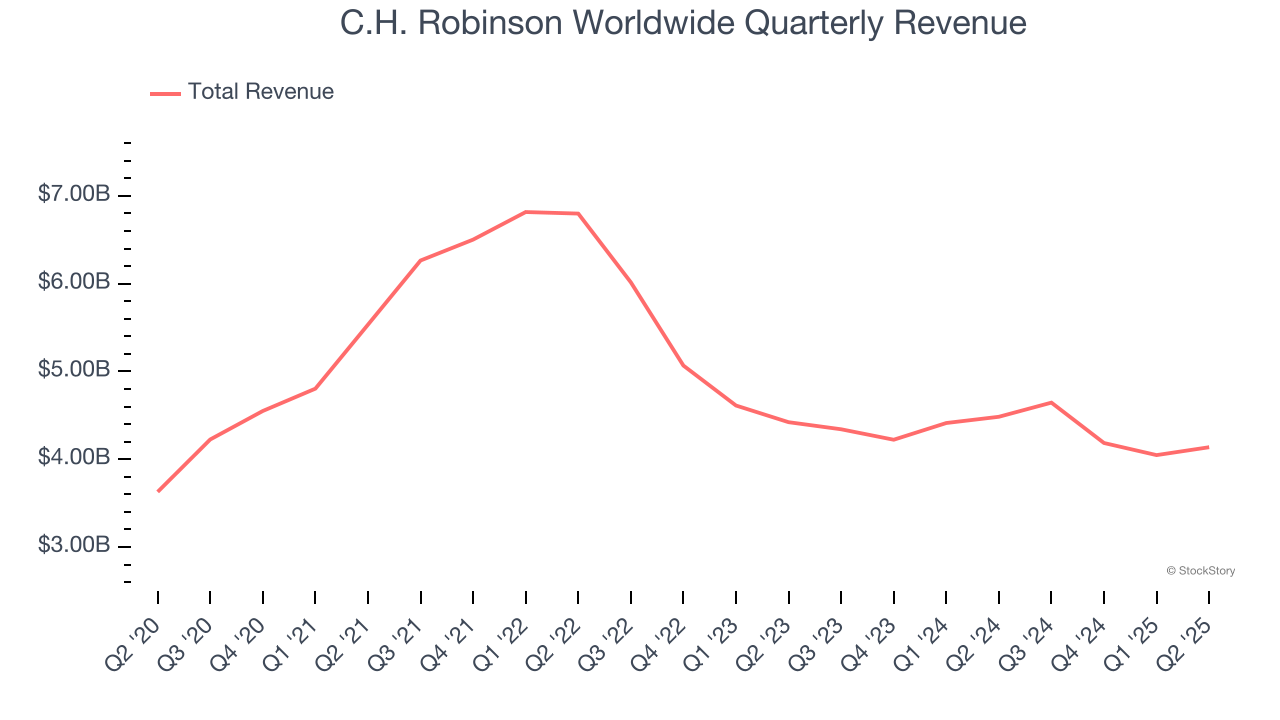
Long-term growth is the most important, but within industrials, a half-decade historical view may miss new industry trends or demand cycles. C.H. Robinson Worldwide’s performance shows it grew in the past but relinquished its gains over the last two years, as its revenue fell by 8% annually. C.H. Robinson Worldwide isn’t alone in its struggles as the Air Freight and Logistics industry experienced a cyclical downturn, with many similar businesses observing lower sales at this time. 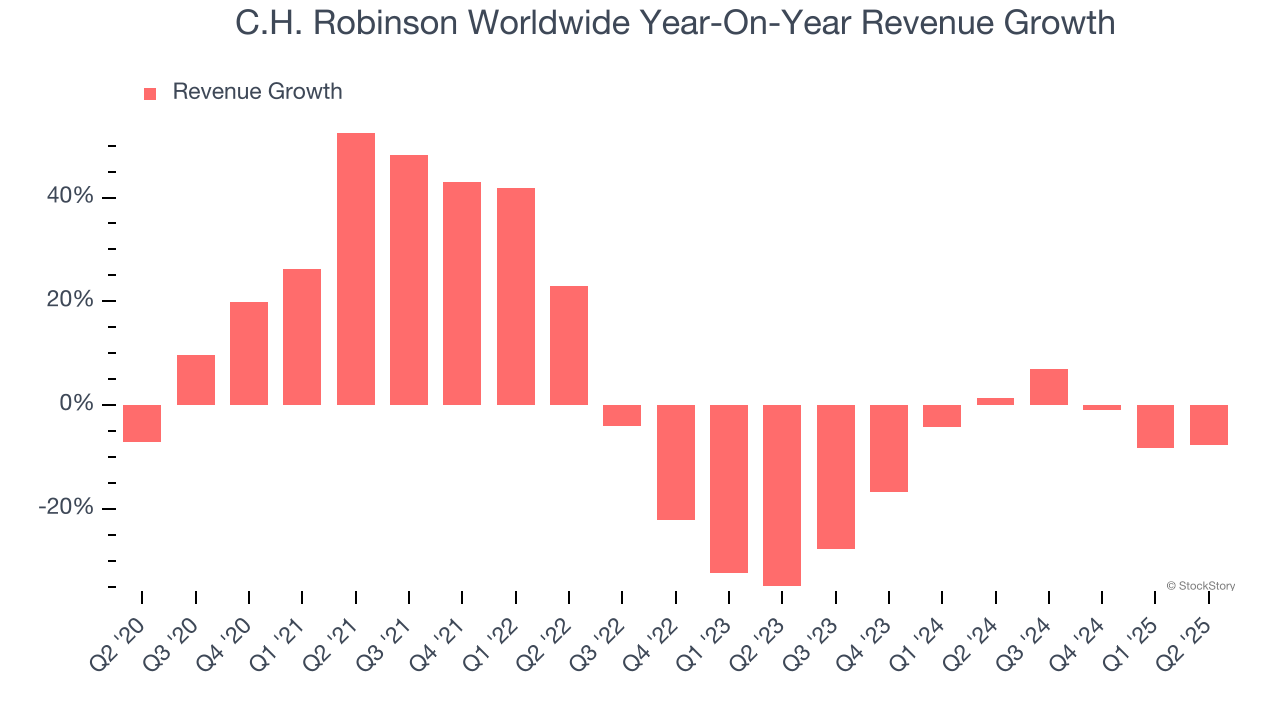
C.H. Robinson Worldwide also breaks out the revenue for its most important segments, North American surface transportation and Global Forwarding, which are 70.5% and 19.3% of revenue. Over the last two years, C.H. Robinson Worldwide’s North American surface transportation revenue (transportation brokerage) averaged 8.6% year-on-year declines while its Global Forwarding revenue (worldwide ocean, air, customers ) was flat.
This quarter, C.H. Robinson Worldwide missed Wall Street’s estimates and reported a rather uninspiring 7.7% year-on-year revenue decline, generating $4.14 billion of revenue.
Looking ahead, sell-side analysts expect revenue to remain flat over the next 12 months. Although this projection indicates its newer products and services will spur better top-line performance, it is still below the sector average.
Software is eating the world and there is virtually no industry left that has been untouched by it. That drives increasing demand for tools helping software developers do their jobs, whether it be monitoring critical cloud infrastructure, integrating audio and video functionality, or ensuring smooth content streaming. Click here to access a free report on our 3 favorite stocks to play this generational megatrend.
Operating Margin
Operating margin is an important measure of profitability as it shows the portion of revenue left after accounting for all core expenses – everything from the cost of goods sold to advertising and wages. It’s also useful for comparing profitability across companies with different levels of debt and tax rates because it excludes interest and taxes.
C.H. Robinson Worldwide’s operating margin has been trending up over the last 12 months and averaged 4.3% over the last five years. The company’s higher efficiency is a breath of fresh air, but its suboptimal cost structure means it still sports lousy profitability for an industrials business. This result isn’t too surprising given its low gross margin as a starting point.
Looking at the trend in its profitability, C.H. Robinson Worldwide’s operating margin might fluctuated slightly but has generally stayed the same over the last five years. This raises questions about the company’s expense base because its revenue growth should have given it leverage on its fixed costs, resulting in better economies of scale and profitability. C.H. Robinson Worldwide’s performance was poor, but we noticed this is a broad theme as many similar Air Freight and Logistics companies saw their margins fall (along with revenue, as mentioned above) because the cycle turned in the wrong direction.
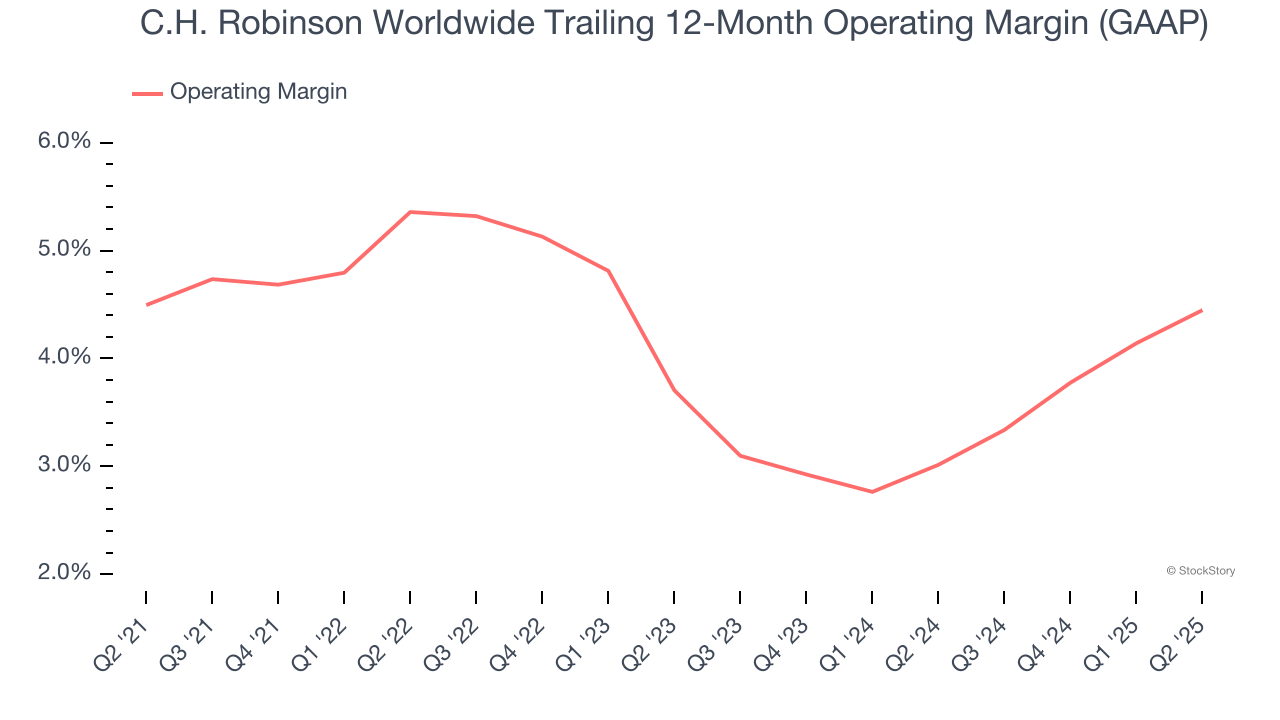
This quarter, C.H. Robinson Worldwide generated an operating margin profit margin of 5.2%, up 1.2 percentage points year on year. Since its gross margin expanded more than its operating margin, we can infer that leverage on its cost of sales was the primary driver behind the recently higher efficiency.
Earnings Per Share
We track the long-term change in earnings per share (EPS) for the same reason as long-term revenue growth. Compared to revenue, however, EPS highlights whether a company’s growth is profitable.
C.H. Robinson Worldwide’s EPS grew at an unimpressive 7.8% compounded annual growth rate over the last five years. This performance was better than its flat revenue but doesn’t tell us much about its business quality because its operating margin didn’t improve.
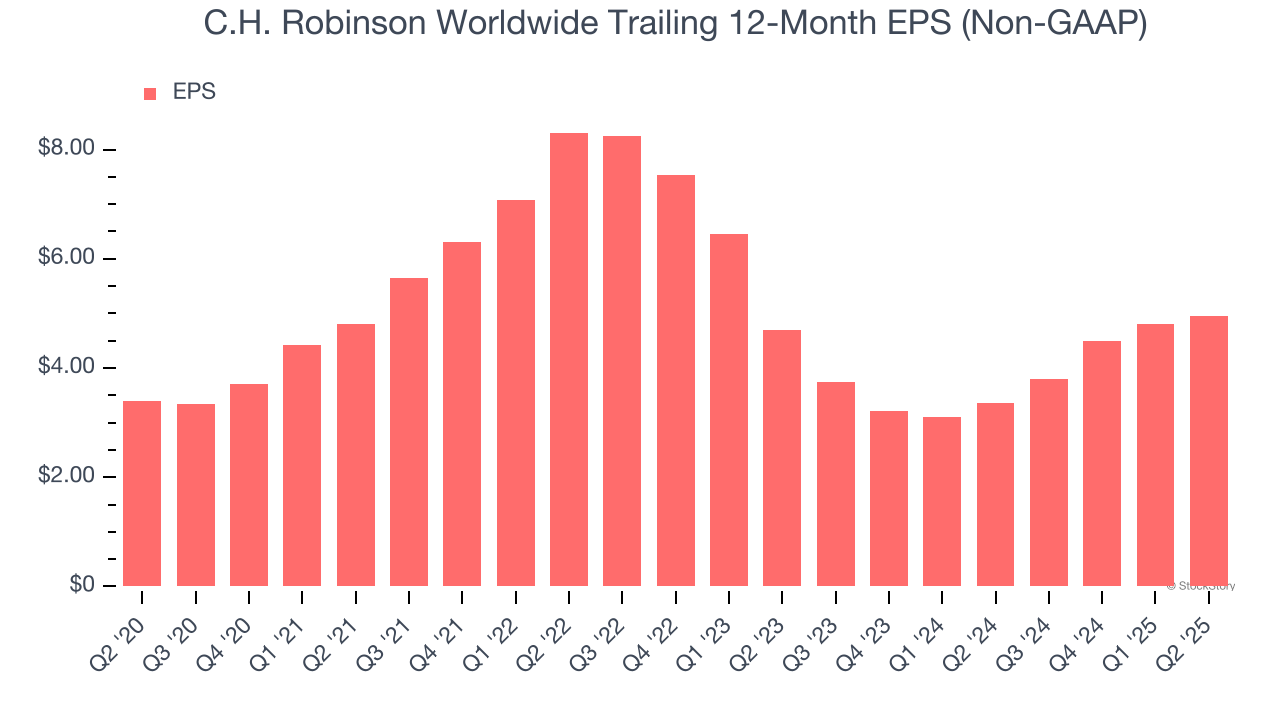
Diving into the nuances of C.H. Robinson Worldwide’s earnings can give us a better understanding of its performance. A five-year view shows that C.H. Robinson Worldwide has repurchased its stock, shrinking its share count by 10.8%. This tells us its EPS outperformed its revenue not because of increased operational efficiency but financial engineering, as buybacks boost per share earnings. 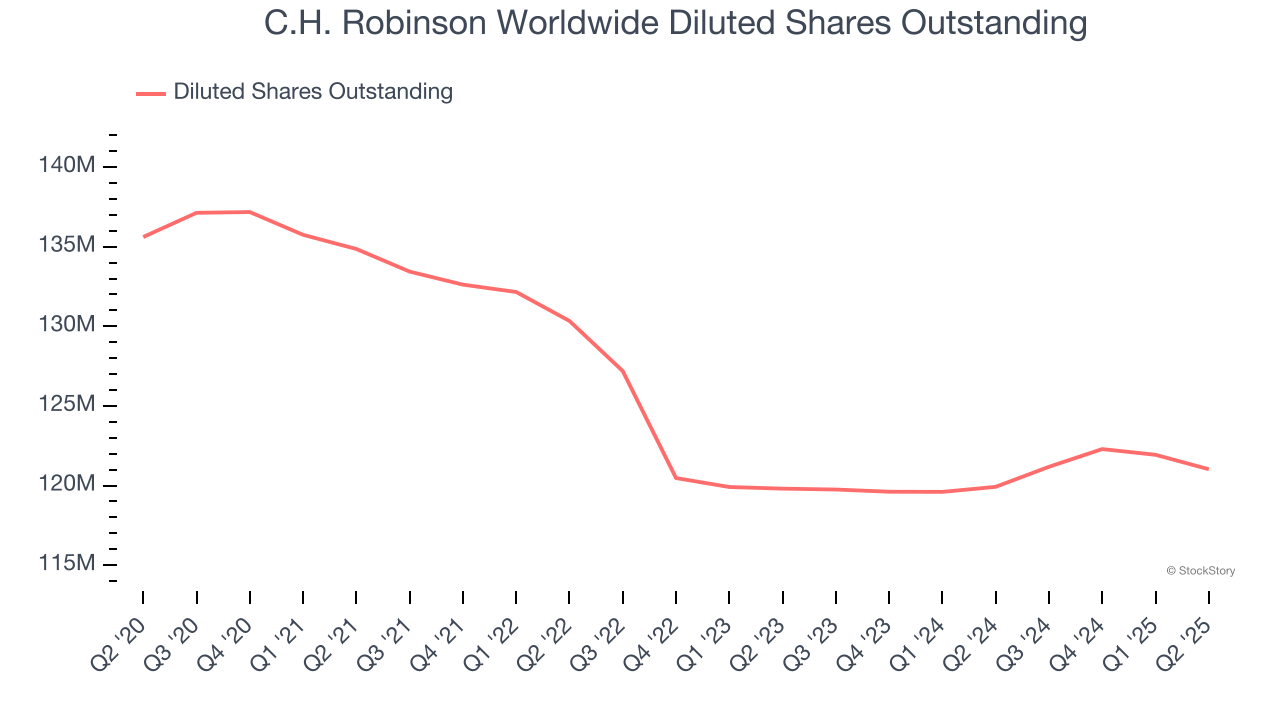
Like with revenue, we analyze EPS over a more recent period because it can provide insight into an emerging theme or development for the business.
For C.H. Robinson Worldwide, its two-year annual EPS growth of 2.7% was lower than its five-year trend. We hope its growth can accelerate in the future.
In Q2, C.H. Robinson Worldwide reported adjusted EPS at $1.29, up from $1.15 in the same quarter last year. This print easily cleared analysts’ estimates, and shareholders should be content with the results. Over the next 12 months, Wall Street expects C.H. Robinson Worldwide’s full-year EPS of $4.95 to stay about the same.
Key Takeaways from C.H. Robinson Worldwide’s Q2 Results
It was encouraging to see C.H. Robinson Worldwide beat analysts’ EPS expectations this quarter. We were also glad its Global Forwarding revenue topped Wall Street’s estimates. On the other hand, its consolidated revenue slightly missed and its EBITDA also fell slightly short of Wall Street’s estimates. Zooming out, we think this was a mixed quarter. The stock remained flat at $97.40 immediately after reporting.
Is C.H. Robinson Worldwide an attractive investment opportunity right now? We think that the latest quarter is only one piece of the longer-term business quality puzzle. Quality, when combined with valuation, can help determine if the stock is a buy. We cover that in our actionable full research report which you can read here, it’s free.






